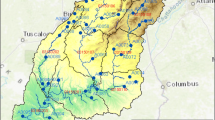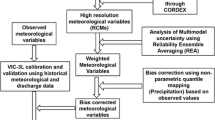Abstract
In this paper, long-term hydrological response of a watershed to climate change was investigated taking into account the spatial scale effect on the performance of hydrological models. A water balance model was used in which variations of soil moisture, snow budget, deep infiltration and interactions with groundwater resources were modeled. Four various combinations of sub-catchment delineation, altitudinal discretization and division into square-shaped grids were tested for semi-distributed water balance modeling of a basin located in southwest of Iran, namely Roodzard Basin, with arid and semiarid climate based on Köppen-Geiger climate classification. The results showed improvement in the model performances when spatial variations of the meteorological data and topographic characteristics of the basin were incorporated in the modeling process. The effects of spatial scale resolution dependency were evaluated in projecting streamflow for various climate change scenarios. The results showed that finer resolution of grid cells in the semi-distributed model does not necessarily result in more accurate estimation of monthly streamflows and altitudinal discretization provides almost same accuracy as the results of grid-based models. Moreover, probability distribution of projections obtained from water balance models for A2 and B2 of Special Report on Emissions Scenarios (SRES) scenarios presented less coefficient of variation and skewness compared with historical observations.






Similar content being viewed by others
Notes
Probability Distributed Moisture models
Topographic Model
References
Asadieh B, Krakauer NY (2017) Global change in streamflow extremes under climate change over the 21st century. Hydrol Earth Syst Sci 21:5863–5874
Beven K (1989) Changing ideas in hydrology - the case of physically-based models. J Hydrol 105:157–172
Chen X, David Chen Y, Xu C-y (2007) A distributed monthly hydrological model for integrating spatial variations of basin topography and rainfall. Hydrol Process 21:242–252
Dunne KA (1996) Global distribution of plant extractable water capacity of soil. Int J Climatol 16:841–859
Grayson RM (1992) Physically based hydrologic modeling: 1. A terrain-based model for investigative purposes. Water Resour Res 28:2639–2658
Guo S, Chen H, Zhang H, Xiong L, Liu P, Wang G (2005) A Semi-Distributed Monthly Water Balance Model and Its Application in Climate Change Impact study in the Middle and Lower Yellow River Basin. Water Int 30(2):250–260
Hlavcova, K., Cunderlik, J. (1998). Impact of climate change on the seasonal distribution of runoff in mountainous basins in Slovakia, Hydrology, Processding of Water Resources and Ecology in Headwaters, 1AHS Publ. no. 248, pp. 39–46
Im S-S, Kim H-S, Sep B-H (2001) A study on Computation Methods of Monthly Runoff by Water Balance Method. J Korea Water Resour Assoc 34(6):713–724
Kottek M, Grieser J, Beck C, Rudolf B, Rubel F (2006) World Map of the Köppen-Geiger climate classification updated. Meteorol Z 15:259–263
Kour R, Patel N, Krishna AP (2016) Climate and hydrological models to assess the impact of climate change on hydrological regime: a review. Arab J Geosci 9:544. https://doi.org/10.1007/s12517-016-2561-0.
Kuchar L, Szalińska W, Iwański S, Jelonek L (2014) A modeling framework to assess the impact of climate change on a river runoff. Meteorol Hydrol Water Manag 2(2):49–64
Lee H, McIntyre N, Wheater H, Young A (2005) Selection of conceptual models for regionalization of the rainfall-runoff relationship. J Hydrol 312(1–4):125–147
Ljung L (1999) System Identification: Theory for the User. Prentice-Hal PTR, Upper Saddle River
Mishra A, Hata T (2006) A grid-based runoff generation and flow routing model for upper blue Nile basin. Hydrol Sci J 51(2):191–206
Nasseri M, Zahraie B, Ajami NK, Solomatine DP (2014a) Monthly Water Balance Modeling: Probabilistic, Possibilistic and Hybrid Methods for Model Combination and Ensemble Simulation. J Hydrol 511:675–691
Nasseri M, Ansari A, Zahraie B (2014b) Uncertainty Assessment of Hydrological Models with Fuzzy Extension Principle: Evaluation of a New Arithmetic Operator. Water Resour Res 50:1095–1111. https://doi.org/10.1002/2012WR013382
Nasseri M, Zahraie B, Forouhar L (2017) A Comparison Between Direct and Indirect Frameworks to Evaluate Impacts of Climate Change on Streamflows: Case Study of Karkheh River Bsin in Iran. J Water Clim Chang https://doi.org/10.2166/wcc.2017.043
Olea RA (2006) A six-step practical approach to semivariogram modeling. Stoch Env Res Risk A 20:307–318
Panagouliaa D, Dimoub G (1997) Linking space–time scale in hydrological modelling with respect to global climate change: Part 1. Models, model properties, and experimental design. J Hydrol 194(1–4):15–37. https://doi.org/10.1016/S0022-1694(96)03220-9
Pechilivanidis IM (2010) Calibration of the semi-distributed PDM rainfall-runoff model in the upper LEE cathcment, UK. J Hydrol 386:198–209
Peel MC, Finlayson BL, McMahon TA (2007) Updated world map of the Köppen-Geiger climate classification. Hydrol Earth Syst Sci 11:1633–1644. https://doi.org/10.5194/hess-11-1633-2007
Piniewski M, Voss F, Bärlund I, Okruszko T, Kundzewicz ZW (2013) Effect of modelling scale on the assessment of climate change impact on river runoff. Hydrol Sci J 58(4):737–754. https://doi.org/10.1080/02626667.2013.778411
Piniewski M, Meresa HK, Romanowicz R, Osuch M, Szcześniak KI, Okruszko T, Mezghani A, Kundzewicz ZW (2017) What can we learn from the projections of changes of flow patterns? Results from Polish case studies. Acta Geophysica 65(4):809–827
Rinaldo A, Marani A, Rigon R (1991) Geomorphological disspersion. Water Resour Res 27(4):513–525
USDA-SCS (1985) National Engineering Handbook. Section 4-Hydrology. USDA-SCS, Washington DC.
Saghafian B, Ghasemi SA, Nasseri M (2018) Backcasting Long Term Climate Data: Evaluation of Hypothesis. Theor Appl Climatol 134(3–4):717–726. https://doi.org/10.1007/s00704-017-2113-x
Solomatine DP, Wagener T (2011) Hydrological Modeling. In: Wilderer P (ed) Treatise on Water Science, vol 2. Academic Press, Oxford, pp 435–457
Smith MB, Koren V, Reed S, Zhang Z, Zhang Y, Moreda F, Cui Z, Mizukami N, Anderson EA, Cosgrove BA (2012) The distributed model intercomparison project–Phase 2: Motivation and design of the Oklahoma experiments. J Hydrol 418–419:3–16
Tavakol-Davani H, Nasseri M, Zahraie B (2012) Improved statistical downscaling of daily precipitation using SDSM platform and data-mining methods. Int J Climatol 33(11):2561–2578
Tong, H. (1983). Threshold models in non-linear time series analysis. Springer.
Vörösmarty MB (1989) A continental-scale model of water balance and fluvial transport: application to South America. Glob Biogeochem Cycles 3:241–265
XU CH-Y (1999) Climate Change and Hydrologic Models: A Review of Existing Gaps and Recent Research Developments. Water Resour Manag 13:369–382
Zhao RJ (1992) The Xinanjiang model applied in China. J Hydrol 135:371–381
Author information
Authors and Affiliations
Corresponding author
Ethics declarations
Conflict of Interest
None.
Electronic supplementary material
ESM 1
(DOCX 60 kb)
Rights and permissions
About this article
Cite this article
Nasseri, M., Zahraie, B. & Tootchi, A. Spatial Scale Resolution of Prognostic Hydrological Models: Simulation Performance and Application in Climate Change Impact Assessment. Water Resour Manage 33, 189–205 (2019). https://doi.org/10.1007/s11269-018-2096-0
Received:
Accepted:
Published:
Issue Date:
DOI: https://doi.org/10.1007/s11269-018-2096-0




